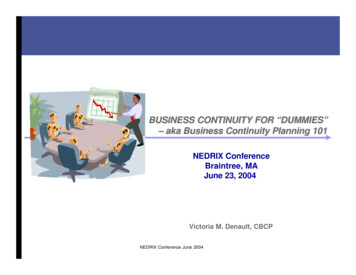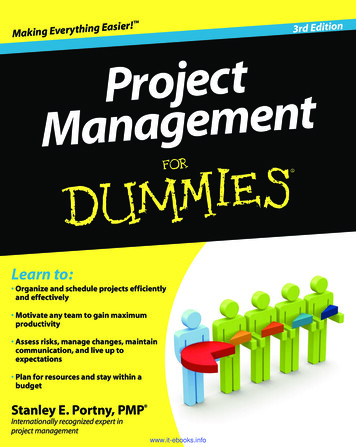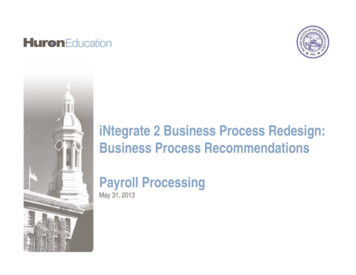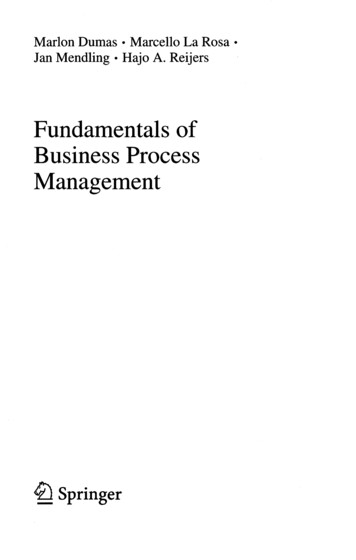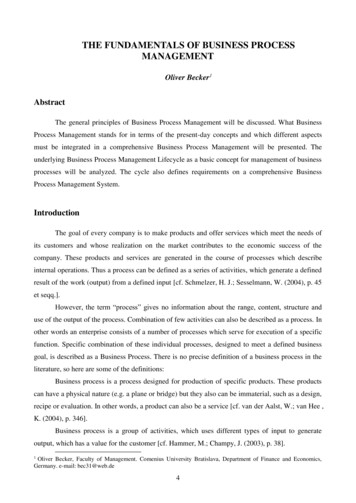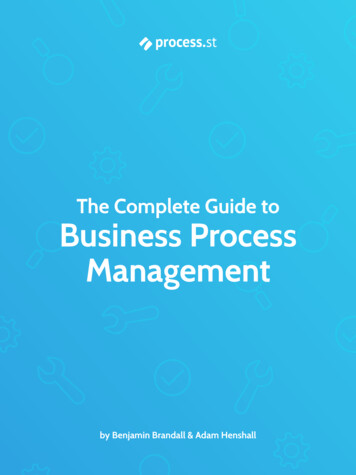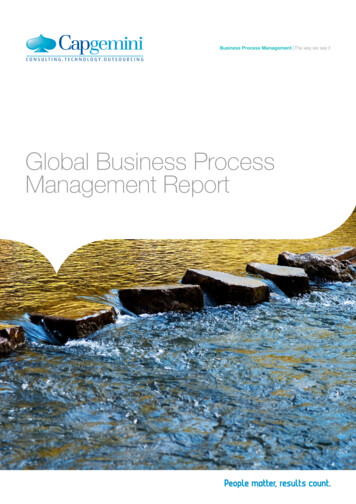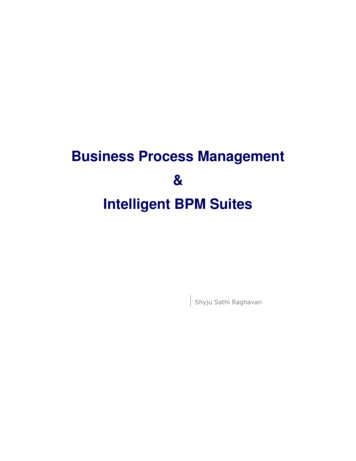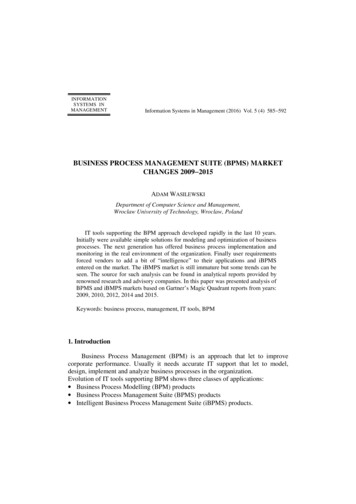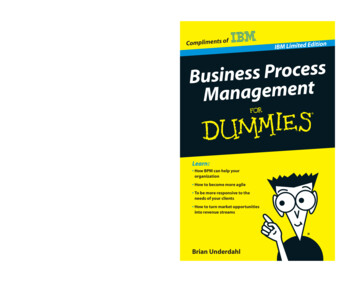
Transcription
Compliments ofThe time is now to use BPMto give your organizationthe edge it’s been looking for Ways to achieve compliance Tips for controlling yourcosts How IBM can help youtransform yourorganization with BPMBusiness Process ManagementIn today’s dynamic business environment, yourorganization needs to be ready to turn signals fromthe marketplace into strategic plays. BPM helps youquickly find and execute on missed opportunitiestrapped inside day-to-day operational processes. Byunleashing the power of technology as a competitiveadvantage, your entire enterprise becomes far moreagile, helping you meet your goals. BPM creates valuethrough growth, improved performance, betterproductivity, higher staff effectiveness, and bettercustomer service.Open the book and find:ssecorPssBusinetnemegaMan Increase your productivity — in today’seconomy you need to do more with less Apply BPM principles — to help yourenterprise increase its productivity Take advantage of the new marketopportunities — with BPM, you can be amarket maker and leave your competitionbehind Reach the global market — BPM streamlinesyour supply chain operations to takeadvantage of opportunities wherever theymay existMaking Everything Easier! Learn: How BPM can help yourorganizationGo to Dummies.com for videos, step-by-step examples,how-to articles, or to shop! How to become more agile To be more responsive to theneeds of your clients How to turn market opportunitiesinto revenue streams Accelerate innovation — let BPM transformyour organization into an innovative machineUnderdahlISBN: 978-1-118-01415-8Part #: WSM14002-USEN-00Not for resalenIBM Limited EditioBrian Underdahl
These materials are the copyright of Wiley Publishing, Inc. and anydissemination, distribution, or unauthorized use is strictly prohibited.Untitled-1 12/8/11 7:00 PM
Business ProcessManagementFORDUMmIES‰IBM LIMITED EDITIONby Brian UnderdahlThese materials are the copyright of Wiley Publishing, Inc. and anydissemination, distribution, or unauthorized use is strictly prohibited.
Business Process Management For Dummies , IBM Limited EditionPublished byWiley Publishing, Inc.111 River StreetHoboken, NJ 07030-5774www.wiley.comCopyright 2011 by Wiley Publishing, Inc., Indianapolis, IndianaPublished by Wiley Publishing, Inc., Indianapolis, IndianaNo part of this publication may be reproduced, stored in a retrieval system or transmitted in anyform or by any means, electronic, mechanical, photocopying, recording, scanning or otherwise,except as permitted under Sections 107 or 108 of the 1976 United States Copyright Act, without theprior written permission of the Publisher. Requests to the Publisher for permission should beaddressed to the Permissions Department, John Wiley & Sons, Inc., 111 River Street, Hoboken, NJ07030, (201) 748-6011, fax (201) 748-6008, or online at http://www.wiley.com/go/permissions.Trademarks: Wiley, the Wiley Publishing logo, For Dummies, the Dummies Man logo, A Referencefor the Rest of Us!, The Dummies Way, Dummies.com, Making Everything Easier, and related tradedress are trademarks or registered trademarks of John Wiley & Sons, Inc. and/or its affiliates in theUnited States and other countries, and may not be used without written permission. All other trademarks are the property of their respective owners. Wiley Publishing, Inc., is not associated with anyproduct or vendor mentioned in this book.LIMIT OF LIABILITY/DISCLAIMER OF WARRANTY: THE PUBLISHER AND THE AUTHOR MAKENO REPRESENTATIONS OR WARRANTIES WITH RESPECT TO THE ACCURACY OR COMPLETENESS OF THE CONTENTS OF THIS WORK AND SPECIFICALLY DISCLAIM ALL WARRANTIES,INCLUDING WITHOUT LIMITATION WARRANTIES OF FITNESS FOR A PARTICULAR PURPOSE.NO WARRANTY MAY BE CREATED OR EXTENDED BY SALES OR PROMOTIONAL MATERIALS.THE ADVICE AND STRATEGIES CONTAINED HEREIN MAY NOT BE SUITABLE FOR EVERY SITUATION. THIS WORK IS SOLD WITH THE UNDERSTANDING THAT THE PUBLISHER IS NOTENGAGED IN RENDERING LEGAL, ACCOUNTING, OR OTHER PROFESSIONAL SERVICES. IF PROFESSIONAL ASSISTANCE IS REQUIRED, THE SERVICES OF A COMPETENT PROFESSIONALPERSON SHOULD BE SOUGHT. NEITHER THE PUBLISHER NOR THE AUTHOR SHALL BE LIABLEFOR DAMAGES ARISING HEREFROM. THE FACT THAT AN ORGANIZATION OR WEBSITE ISREFERRED TO IN THIS WORK AS A CITATION AND/OR A POTENTIAL SOURCE OF FURTHERINFORMATION DOES NOT MEAN THAT THE AUTHOR OR THE PUBLISHER ENDORSES THEINFORMATION THE ORGANIZATION OR WEBSITE MAY PROVIDE OR RECOMMENDATIONS ITMAY MAKE. FURTHER, READERS SHOULD BE AWARE THAT INTERNET WEBSITES LISTED INTHIS WORK MAY HAVE CHANGED OR DISAPPEARED BETWEEN WHEN THIS WORK WAS WRITTEN AND WHEN IT IS READ.For general information on our other products and services, please contact our Business DevelopmentDepartment in the U.S. at 317-572-3205. For details on how to create a custom For Dummies book foryour business or organization, contact info@dummies.biz. For information about licensing theFor Dummies brand for products or services, contact BrandedRights&Licenses@Wiley.com.ISBN: 978-1-118-01415-8Manufactured in the United States of America10 9 8 7 6 5 4 3 2 1These materials are the copyright of Wiley Publishing, Inc. and anydissemination, distribution, or unauthorized use is strictly prohibited.
Publisher’s AcknowledgmentsWe’re proud of this book and of the people who worked on it. For details on howto create a custom For Dummies book for your business or organization, contactinfo@dummies.biz. For details on licensing the For Dummies brand for products orservices, contact BrandedRights&Licenses@Wiley.com.Some of the people who helped bring this book to market include the following:Acquisitions, Editorial, and MediaDevelopmentProject Editor: Carrie A. BurchfieldEditorial Manager: Rev MengleSr. Acquisitions Editor: Katie FeltmanBusiness Development Representative:Sue BlessingCustom Publishing Project Specialist:Michael SullivanComposition ServicesSr. Project Coordinator: Kristie ReesLayout and Graphics: Melanee Habig,Lavonne RobertsProofreader: Rebecca DenoncourPublishing and Editorial for Technology DummiesRichard Swadley, Vice President and Executive Group PublisherAndy Cummings, Vice President and PublisherMary Bednarek, Executive Director, AcquisitionsMary C. Corder, Editorial DirectorPublishing and Editorial for Consumer DummiesDiane Graves Steele, Vice President and Publisher, Consumer DummiesComposition ServicesDebbie Stailey, Director of Composition ServicesBusiness DevelopmentLisa Coleman, Director, New Market and Brand DevelopmentThese materials are the copyright of Wiley Publishing, Inc. and anydissemination, distribution, or unauthorized use is strictly prohibited.
Table of ContentsIntroduction . . . . . . . . . . . . . . . . . . . . . . . . . . . . . . . . . . . . . .1About This Book . 1How This Book Is Organized . 1Chapter 1: Understanding BPM. 1Chapter 2: Getting Started with BPM . 2Chapter 3: Putting BPM to Work for YourOrganization . 2Chapter 4: Improving BPM Automation withDecision Management . 2Chapter 5: Checking out BPM Success Stories . 2Chapter 6: Top Reasons to Choose BPM from IBM . 2Icons Used in This Book . 3Chapter 1: Understanding BPM . . . . . . . . . . . . . . . . . . . . .5BPM: The New, Agile Business Model . 5Understanding How BPM Benefits Your Business . 6Making faster decisions . 7Making better decisions. 8Making financially sound decisions . 8Why Changing to BPM Now Makes Sense . 9It’s a tough market out there. 9Waiting won’t improve things . 10Take advantage of the opportunities . 11Why Existing Tools Just Won’t Do . 11Buying a packaged application . 12Extending an existing application. 13Traditional application development . 14The BPM advantage . 15Chapter 2: Getting Started with BPM . . . . . . . . . . . . . . .17Evaluating Your Company’s Needs. 17Selecting the Right Project . 18Process analysis. 19Initiation: Starting small and scaling up . 20Transformation: Making changes . 21Proving value. 21Understanding Your Options . 22Functionality options . 22Time to value . 23These materials are the copyright of Wiley Publishing, Inc. and anydissemination, distribution, or unauthorized use is strictly prohibited.
Table of ContentsAdditional value-added capabilities . 23Considering the top BPM vendors . 23Understanding the IBM Advantage . 24BPM with SOA . 24Rapid process implementation . 25Content management, workflow, andcollaboration capabilities . 25Blueworks Live . 26Chapter 3: Putting BPM to Workfor Your Organization . . . . . . . . . . . . . . . . . . . . . . . . . . .27Planning, Planning, Planning . 27Choosing the correct project/process . 28Selling BPM to management . 28Selling BPM to your colleagues . 29Building a BPM Solution . 30A typical BPM project scenario . 30BPM project resources . 31Software resources . 32People resources. 32Hardware resources . 32Documenting Your Process . 33Documenting the changes . 33Understanding BPM architecture . 33Documenting processes. 34Process simulation . 35Chapter 4: Improving BPM Automationwith Decision Management . . . . . . . . . . . . . . . . . . . . .37Understanding Decision Management . 37Driving Process Improvement . 38Understanding business rules. 38Scattered business rules . 39Business rule management systems . 40Understanding business events . 40Business event processing . 41Combining BRMS and BEP . 42Automating and Improving Decision-Making . 43Real-world scenarios . 43Using BRMS and BEP in the financialservices industry . 43Using BRMS and BEP in other industries . 44The role of analytics in decision management . 46These materials are the copyright of Wiley Publishing, Inc. and anydissemination, distribution, or unauthorized use is strictly prohibited.v
viBusiness Process Management For Dummies, IBM Limited EditionChapter 5: Checking out BPM Success Stories . . . . . . .49Growing with Mobitel . 49Reducing Medical Costs for Medizinische HochschuleHannover . 52Getting Airborne with Atlas Air Worldwide Holdings . 54Suiting Up with Mark’s Work Wearhouse . 57Going Paperless at Wüstenrot & Württembergische AG . 60Chapter 6: Top Reasons to Choose BPM from IBM . . . .61Ease of Use . 61Dynamic SOA Capabilities . 61Role-based User Environment . 62Integrated BAM Capabilities . 62Advanced Programming Model . 62Scalability and Performance . 63Documenting and Running Processes in the Cloud . 63Business Rule Management . 63Business Event Processing . 64Beyond Technology, Assuring Success with BPM Services . 64These materials are the copyright of Wiley Publishing, Inc. and anydissemination, distribution, or unauthorized use is strictly prohibited.
IntroductionAre you ready to tackle Business Process Management(BPM) for your enterprise? Do you want to improveefficiency, enhance agility, and also be more profitable? If so,you’ve come to the right place.BPM is an approach toward managing how an organizationoperates so it better meets the needs of clients. BPM enablesorganizations to be more efficient and more capable of change.BPM is exactly what your organization needs to meet thechallenges of the modern business climate.About This BookBusiness Process Management For Dummies, IBM LimitedEdition, shows you what BPM is and how it can help yourorganization. You see how the BPM solutions from IBM helpyou gain many benefits from higher customer satisfaction togreater agility in adapting to changing market conditions.How This Book Is OrganizedThis book is divided into six chapters, which can be read inany order. This section contains a brief breakdown of whatyou find in each chapter, so you can skip to whatever chapterthat interests you the most.Chapter 1: Understanding BPMChapter 1 discusses the new agile business model that’s BPMand shows you why changing to BPM now makes sense foryour organization.These materials are the copyright of Wiley Publishing, Inc. and anydissemination, distribution, or unauthorized use is strictly prohibited.
2Business Process Management For Dummies, IBM Limited EditionChapter 2: Getting Startedwith BPMChapter 2 shows you how to evaluate your company’s needsand how to select the correct first project. In addition, yousee the BPM options that are available to you. Each of themoffers benefits, such as reducing costs, improving agility, andincreasing efficiency.Chapter 3: Putting BPM to Workfor Your OrganizationIn Chapter 3, I discuss the planning process for putting BPM towork in your company. You see how to build a BPM solution andhow to make sure that you’re correctly documenting everything.Chapter 4: Improving BPMAutomation with DecisionManagementChapter 4 discusses decision management and shows youhow to drive process improvement. Finally, you see how toautomate and improve the decision-making process.Chapter 5: Checking outBPM Success StoriesIn Chapter 5, you see several success stories that show youhow IBM’s BPM solutions help companies all around theworld to become more agile and successful.Chapter 6: Top Reasonsto Choose BPM from IBMChapter 6 gives you the top reasons why you should choosea BPM solution from IBM. Check it out; one of them may justconvince you to switch.These materials are the copyright of Wiley Publishing, Inc. and anydissemination, distribution, or unauthorized use is strictly prohibited.
IntroductionIcons Used in This BookThis book uses the following icons to call your attention toinformation you may find helpful in particular ways.The information in paragraphs marked by the Remember iconis important and therefore repeated for emphasis. This way,you can easily spot the information when you refer to the booklater.The Tip icon indicates extra-helpful information. You may discover how to get the most experts in the field or a fascinatingway to implement your BPM or save time or money.This icon marks places where technical matters are discussed. Sorry, it can’t be helped; plus, the information isintended to be helpful.Paragraphs marked with the Warning icon call attention tocommon pitfalls that you may encounter.These materials are the copyright of Wiley Publishing, Inc. and anydissemination, distribution, or unauthorized use is strictly prohibited.3
4Business Process Management For Dummies, IBM Limited EditionThese materials are the copyright of Wiley Publishing, Inc. and anydissemination, distribution, or unauthorized use is strictly prohibited.
Chapter 1Understanding BPMIn This Chapter Seeing BPM as the new, agile business model Recognizing how BPM benefits your business Switching to BPM Going beyond existing toolsBetter processes produce lower cost, higher revenues,motivated employees, and happier customers. BusinessProcess Management (BPM) is an approach that’s designedto produce better processes. BPM is a collaborative effortbetween business units and the IT world, and this effort fostersa new paradigm of efficient and logical business processes.In this chapter, you get an introduction to BPM and see howit can benefit your business. You also see why now is a goodtime to implement BPM and why your existing tools just won’tdo the job.BPM: The New, AgileBusiness ModelIn today’s dynamic business environment, organizations needto be agile so they’re ready to respond to whatever challengescome their way. BPM provides that agility by giving you moredirect control over your operational processes. You can makebetter use of technology and your entire enterprise becomesfar more responsive, helping you meet your goals.BPM helps create value for the enterprise through growth,improved performance, better productivity, higher staffThese materials are the copyright of Wiley Publishing, Inc. and anydissemination, distribution, or unauthorized use is strictly prohibited.
6Business Process Management For Dummies, IBM Limited Editioneffectiveness, and better customer service. All of theseimprovements result directly from improved processes.BPM can help your organization become more agile in anumber of different ways: Increased productivity: In today’s economy you need todo more with fewer resources. Applying BPM principleshelps your enterprise increase its productivity. Speed to market: When a new idea or product comesalong, effective BPM helps you be one of the leaders, notone of the followers who were too late to take advantageof the new market. Reaching the global market: BPM can help you streamline your supply chain operations, so you can takeadvantage of opportunities no matter where they mayexist. Achieving compliance: Keeping up with complex compliance, regulatory, and corporate governance requirements can be very costly and time-consuming. UsingBPM, you can keep these costs under control. Accelerating innovation: You need a business environment where innovation isn’t only encouraged but alsowhere innovation is a normal part of daily operation.Here, too, BPM can help make that possible.The agile and flexible organization has the ability to meet theneeds of the customer and be the winner at the end of the day.Practices such as Six Sigma and Lean Six Sigma as well asthe work of quality control experts such as Deming are fullyincorporated in BPM methodology. BPM actually enables youto leverage these practices to provide even greater benefits toyour enterprise. For more information on Six Sigma, check outits full retail title, Six Sigma For Dummies.Understanding How BPMBenefits Your BusinessThe basic operational value proposition of BPM is the ability to process more with less effort and higher quality. As aThese materials are the copyright of Wiley Publishing, Inc. and anydissemination, distribution, or unauthorized use is strictly prohibited.
Chapter 1: Understanding BPM7result, BPM has become a cornerstone discipline for companies that want to grow revenues quickly while controllingresource costs.Business processes are pervasive in any organization. Theseprocesses represent all the activities that organizations inall industries undertake. Some processes are highly structured, such as high-volume manufacturing processes, whileothers, such as medical care that must be tailored to specificpatients’ needs, are more unstructured.You may not think of the activities performed within yourorganization as business processes, but that’s exactly whatthey are. As you try to improve your operations, you’re engaging in a process improvement project. Clearly, you want toleverage advanced methodologies and technologies to deliverconsistent, repeatable, and more efficient outcomes as youwork on this improvement project. BPM helps you defineand manage your business processes so you can reach yourdesired goals.Making faster decisionsSpeed and agility are very important factors in the successof any business. Take the fast-food restaurant business asan example. Look at any fast-food restaurant on the cornerduring lunchtime. They serve many times the number oflunches of the typical sit down restaurant simply because theindustry is fast. People typically have a limited amount of timefor lunch, and they know that the fast-food restaurant willserve them quickly. Customers don’t like to wait for productsor answers.This example is excellent for seeing how managing a businessprocess effectively can greatly improve the speed of an operation. By using BPM, your managers have unimpeded access todata as well as well-defined systems to help them make decisions quickly.Typically, when organizations thought about processimprovement, they focused on the orchestration of the various tasks that comprise the end-to-end process. But thedecisions that take place in the process are equally important. BPM can help you automate high-volume operationaldecisions so they can be made more quickly and in a highlyThese materials are the copyright of Wiley Publishing, Inc. and anydissemination, distribution, or unauthorized use is strictly prohibited.
8Business Process Management For Dummies, IBM Limited Editionrepeatable manner. In this way, managers gain the tools theyneed to more easily make important decisions quickly.Making better decisionsBecause BPM can help make sure that your managers havecomplete information, they’re able to make better decisions.In addition, by helping you automate many decision-makingprocesses, by using BPM, you can be sure that most decisionsare made in a much more consistent manner. Because thesedecisions are based on solidly defined rules, they’re likely tobe more in line with the goals of your organization.BPM also enables you to see your processes in action and tosee how decisions affect your bottom line. As a result, you’reable to do more than simply react; you can alter the processto better manage new opportunities or looming threats. BPMgives you the tools to improve the processes and decisionsproactively. This process improvement ultimately means thatdecisions aren’t only made faster, but also better decisionsare made.Making financially sounddecisionsIn addition to fast and better decisions, your company mayabsolutely require that any decisions be financially sound.No company can stay afloat for very long if it’s throwing awaymoney. Virtually every decision made within an organizationaffects the bottom line.BPM helps you create processes that can be quantified interms of financial results. By using BPM, the decisions thatare made can help maximize the financial returns by minimizing time spent, maximizing the use of resources, and reducing waste to an absolute minimum. Through the use of BPM,management is no longer in the dark when it comes to makingimportant financial decisions. Rather, it’s able to see the bigpicture so it can make fiscally responsible decisions for theenterprise.BPM helps you automate the decision-making process byusing a business rules approach. Because your business rulesThese materials are the copyright of Wiley Publishing, Inc. and anydissemination, distribution, or unauthorized use is strictly prohibited.
Chapter 1: Understanding BPM9are defined based on financially sound foundations, thoseautomated decisions automatically are based on financiallysound foundations also.The bottom line is that BPM can help improve your decisionmaking process by making it faster, more intelligent, and bymaking it return decisions that are financially responsible.Why Changing to BPM NowMakes SenseEvery organization has a number of processes in place, butthere is also likely to be a certain amount of inertia becausepeople are used to doing things certain ways. Sure, peoplemay agree that some improvement may be possible, but without seeing the big picture they don’t see the need for change.Unfortunately, burying your head in the sand simply fills yournostrils with a bunch of gritty sand while leaving the most vulnerable parts of your body exposed. Organizations that ignorethe need for change are doing the equivalent of burying theirhead in the sand. Not only will the problems not go away, butthe competition will rush ahead and win the business race.At its core, BPM takes rigid, independent processes andtransforms them into flexible, choreographed businessservices that work together to create substantial businessvalue. This transformation can help the organization toadapt to an ever faster changing business climate and globaleconomic challenge.It’s a tough market out thereRarely, companies have an entire market all to themselves.Indeed, most enterprises are facing ever-increasing challengesjust trying to hold onto their market share. In fact, in mostcases companies are dealing with more and more competitionevery day.You simply can’t afford to sit still and hope for the best. If youtake this approach, you’ll soon find that your competitors aretaking away all your business.These materials are the copyright of Wiley Publishing, Inc. and anydissemination, distribution, or unauthorized use is strictly prohibited.
10Business Process Management For Dummies, IBM Limited EditionWhat do you need to do to be competitive in tough markets?Here are a few very important items: Improve productivity: To compete and win, you need tobe profitable. One of the best ways to improve profitability is by improving your productivity. If you can improveyour productivity so your product or service costs youless to deliver, it’s much easier to compete against lowcost competitors. Improve decision-making: Automating the decisionmaking process leads to faster, better, and more fiscallyresponsible decisions based on business rules. Of course,automating the decision-making process also has positiveeffects on productivity. Improve flexibility: Market demands seem to changealmost overnight making flexibility and agility one of theprimary keys to success today. If you can’t deliver whatthe customers want tomorrow, you may as well be in thebuggy whip business — there isn’t a lot of demand, butyou have the market cornered on obsolete products noone wants.Waiting won’t improve thingsThere’s no question that people have been living throughsome tough economic times. Many people and organizationssee a poor economy as a reason to sit on the sidelines andwait for things to improve before making any decisions. Theirrationale seems to be that doing nothing costs nothing. Onthe surface, this rationale may seem correct but only if youignore the fact that doing nothing creates a large opportunityfor your competition. While you’re busy doing nothing, youcan bet that your competition is trying to become more productive, more flexible, and more profitable.Waiting for improvement to happen on its own is almost asure path to failure. There’s no better time than when conditions are challenging to make positive improvements inyour business processes. After all, the people within yourorganization are almost certainly aware of the current business conditions, and they know that you need to remaincompetitive.These materials are the copyright of Wiley Publishing, Inc. and anydissemination, distribution, or unauthorized use is strictly prohibited.
Chapter 1: Understanding BPM11Take advantage of theopportunitiesDifficult times create excellent opportunities for those peopleand organizations that are willing to invest in the future. Whileeveryone else is sitting around complaining, you can begin theplanning and implement changes that ensure a long and profitable future for your organization.By using BPM, you not only improve your current processes,but also you build and deploy new capabilities and improveyour Return on Investment (ROI). In fact, by implementingBPM now, you’ll be able to make the necessary improvementsfaster, at a much lower cost, and you’ll be able to better leverage your existing resources, thus having an even more positive effect on ROI.With BPM, the benefits go beyond what you may expect.For example, your customers are l
For general information on our other products and services, please contact our Business Development Department in the U.S. at 317-572-3205. For details on how to create a custom For Dummies book for your business or organization, cont
